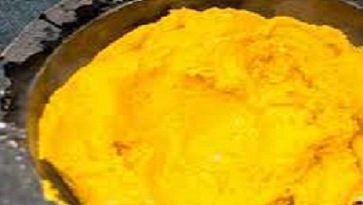Amala Food Nutritional Values | Health Benefits | Health Risk
Amala food nutritional values state the amount of food and the effect of constituents on the body.
It relates to carbohydrates, proteins, fats, minerals, additives, vitamins, enzymes, sugar intake, cholesterol, fat, and salt intake
Amala (yam flour) is a popular food consumed in Nigeria, particularly by the Yoruba Clan.

The amala and ewedu with stew are usually eaten by the Yoruba but nowadays, it has become a family meal in every Nigerian home as well as in some parts of Africa.
Related: Amala Food: How to Prepare Nigerian Amala (Dark Brown Yam Flour)
Hence, it’s not only Nigerian food but, also Amala African food as well. It’s like discovering a new world of food delicacy.
No food is similar to it because it’s so unique. There is no English name for Amala yet.
Table of Contents
Amala Food Nutritional Values: Types of Amala
Amala is of three types: àmàlà isu, àmàlà láfún and “amala ogede”
- Yam flour (àmàlà isu)
This is the most popular type of àmàlà and is derived from yam.
- Cassava flour (àmàlà láfún)
The type is made from cassava flour. Dried cassava flour is known as “lafun” in Nigeria and “kokente” in Ghana.
- Plantain flour (Amala ogee)
This type of Amala is made from plantain, clubs ogee (which is usually lighter in color).
The low carbohydrate level in plantain flour makes it a perfect diet for people diagnosed with diabetes and others who need low-carbohydrate food.
Amala Food Nutritional Values: How Yam Flour (Àmàlà Isu) Is Processed
It’s strange to some, how Amala is processed. Amala is gotten from yam peels. The peels are dried and afterward ground into flour.
In other to process Amala flour, you will need tubes of yams. Finely peel the yams, slice them, and dry them before grounding them into a powder called Elubo.
Amala powder/Elubo is a powerhouse of nutrients. It is rich in Vitamins, calcium, and iron. It helps in boosting your immunity naturally.
Nigerian Amala should not be mistaken for Indian gooseberry, commonly known as amla. Though the spellings are almost the same with a different meanings.
Amla is a very special fruit full of antioxidants that are effective in reducing cell damage which reduces the free radicals that can cause disease in the body
-
What is Amala Food?
It is a Nigerian food made out of plantain flour/yam flour or cassava flour. It is mostly eaten by the Yoruba people of Nigeria.
Nevertheless, one good thing about this meal is that it can be consumed at any time of the day since it digests quickly and easily because it is light.
Amala has a black or dark brown color due to the drying process and as a result of its cooking method.
What is more, the Amala recipe is a must-try in every home since it is nutritious and usually served at every Yoruba party.
The Amala joint in Lagos-Nigeria near me where I like eating my usual continues to triple every day with the likes of:
- Mama Amala Joint
- Amala Yahoo Spot
- Bee Jay Amala Joint
- Just Amala, Ikeja
Amala Food Nutritional Values: Calories, Nutrition Facts/Information
Essentially, Amala has the following important nutrients-Carbohydrate, Calcium, Dietary fiber, Copper, Magnesium, Potassium, and Vitamins
Components Amount
Protein 5g
Fat 2g
Saturated Fat 0g
Sodium 9mg
Sugar 5g
Calories 118g
Polyunsaturated Fat 1g
Dietary Fiber 1g
Cholesterol 0g
Monounsaturated Fat 0g
Potassium 816mg
Carbohydrate 28g
Amala is a rich source of carbohydrates because yam is an important source of carbohydrates for many people in the Sub-Saharan region particularly in the yam zone of West Africa.
Amala Food Health Benefits
The Health Benefits of Amala Food are discussed below:
- Amala food’s nutritional benefits help to build your body formation keep the body intact and help it to fight bacterial and viral diseases.
- It aids in weight loss. The fiber content in Amala helps to flush out toxins from the body making you feel light after eating this food.
- Vitamin A helps with good eyesight, and brain formation, and also lowers inflammations.
- Amala controls the body’s blood formation, stops blood clotting, and stabilizes your blood pressure.
- It aids in lowering bad cholesterol due to its high water content and fiber.
- Amala lifts your body’s immunity; lessens the risk of colon cancer, controls diabetes, and nourishes your skin.
- Lastly, it provides the body with essential minerals, improves hair texture, and aids indigestion.
Eat Amala Food and Live Healthy.
Checkout >>> How to Make Fresh Unripe Plantain Fufu
Health Risk
- The sight is not appealing or inviting to some people. Apart from that, there have been concerns with the preparation of Amala food in some cases.
- Some claim Amala flour is not processed hygienically because of the method used in drying it.
- It’s from the back of a yam and can get mixed up accidentally with bird droppings, sand, etc. during sun drying.
Amala Food Swallow: Health Benefits
Amala is a traditional Nigerian food made from yam flour. While it’s a staple dish in Nigeria, it’s not commonly known outside of West Africa. Here are some potential health benefits of Amala:
Good Source of Carbohydrates
Amala is primarily made from yam flour, which is rich in carbohydrates. Carbohydrates are the body’s primary source of energy, providing fuel for various bodily functions and physical activities.
Dietary Fiber
Yam flour used in making Amala contains dietary fiber, which aids in digestion, promotes bowel regularity, and helps prevent constipation.
A diet high in fiber is associated with a lower risk of various digestive disorders and may contribute to overall gut health.
Vitamins and Minerals
Yam, the main ingredient in Amala, is rich in various vitamins and minerals, including vitamin C, vitamin B6, potassium, manganese, and dietary antioxidants. These nutrients play essential roles in maintaining overall health, supporting immune function, and reducing the risk of chronic diseases.
Gluten-Free
Like many traditional African dishes, amala is naturally gluten-free, making it suitable for individuals with celiac disease or gluten intolerance.
Satiety
The combination of carbohydrates and dietary fiber in Amala can contribute to a feeling of fullness and satiety, which may help control appetite and support weight management when consumed as part of a balanced diet.
Low in Fat
Amala itself is low in fat, which can be beneficial for those aiming to reduce their fat intake or manage their weight.
Cultural Significance
While not a direct health benefit, the cultural significance of Amala should also be acknowledged.
Traditional foods like amala often hold cultural and social importance, promoting a sense of community and connection to cultural heritage.
It’s worth noting that the health benefits of amala can vary depending on factors such as portion size, cooking methods, and the ingredients used in accompanying soups or stews.
As with any food, enjoying amala as part of a balanced diet alongside a variety of other nutrient-rich foods is key to reaping its potential health benefits.



